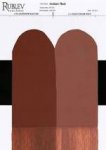If you can wait for it to dry, then Stockholm tar is best....and 3 years is pretty swift.
I have recently learned that the Standing Rigging of Hemp-rigged Warships, right up to the 1850's, was routinely slushed with a mix of ; Stockholm Tar, Coal Tar and water.
Presumably it dried well, or the stuff would have been swilled over everything and everyone and made a right mess..
There is also a watery, tarry, product that Roofers paint atop of newly laid bitumen tarpaulin...I had a roof done with this and it dried to a silvery finish,. pretty much in less than a month.
Personally, I would sooner dry off the rope and store it where well ventilated all round....once it's dry ,give it a good tensioning and then let it relax.
Regards Ceeg


